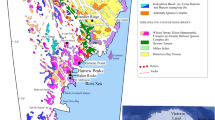Abstract
The postcumulus evolution of a portion of the Bushveld Complex that includes the Merensky reef is inferred from the study of a continuous 56 m drill core. The core penetrated the basal orthopyroxenites of the Merensky and Bastard units, the massive anorthosites overlying the two pyroxenites and about 10 m of norite underlying the Merensky pyroxenite. Detailed profiles of major, minor and rare earth element (REE) contents of clinopyroxene and orthopyroxene were determined by electron and ion probe. Good correlations exist between textural and lithological variations and the REE contents of the pyroxenes. Specifically, enrichments in pyroxene REE abundances are observed in the basal pyroxenites of the Merensky and Bastard units relative to the underlying and overlying rocks. In the pyroxenites the Nd content of clinopyroxene is typically over 12 ppm and reaches nearly 40 ppm (≈90 × chondrite), and Nd/Yb ratio is in the range 8 to 25. These extreme enrichments in REE are not accompanied by large variations in major element contents. Computations of the compaction parameters relevant to the conditions of crystallization of the Bushveld Complex combined with a consideration of cooling history confirm the importance of compaction as a post-cumulus process. This analysis indicates that the geochemical variability is a result of redistribution of interstitial melt driven by compaction and cannot reflect variations in the initial porosity of the accumulating crystal pile. A model for the development of the Atok section is developed. The Merensky anorthosite is interpreted to have served as a barrier to the upward porous flow of late-stage, hydrous and incompatible-element enriched melt, which was thus trapped in the underlying Merensky pyroxenite. The flow was driven by compaction of the 350+ meter-thick section of predominantly norite beneath the anorthosite. The introduction and accumulation of this melt in the pyroxenite and subsequent cooling resulted in partial dissolution, recrystallization and REE enrichment of the rock forming minerals, and in the formation of the main lithologic features of the Merensky pyroxenite. Further upward percolation of the interstitial melt through the Merensky anorthosite was restricted to channels due to the relatively impermeable nature of the cemented anorthosite. This melt accumulated in and metasomatized the Bastard pyroxenite in the same manner as the Merensky pyroxenite, having again been trapped by the overlying Bastard anorthosite.
Similar content being viewed by others
Author information
Authors and Affiliations
Additional information
Received: 10 July 1996 / Accepted: 27 February 1997
Rights and permissions
About this article
Cite this article
Mathez, E., Hunter, R. & Kinzler, R. Petrologic evolution of partially molten cumulate: the Atok section of the Bushveld Complex. Contrib Mineral Petrol 129, 20–34 (1997). https://doi.org/10.1007/s004100050320
Issue Date:
DOI: https://doi.org/10.1007/s004100050320




